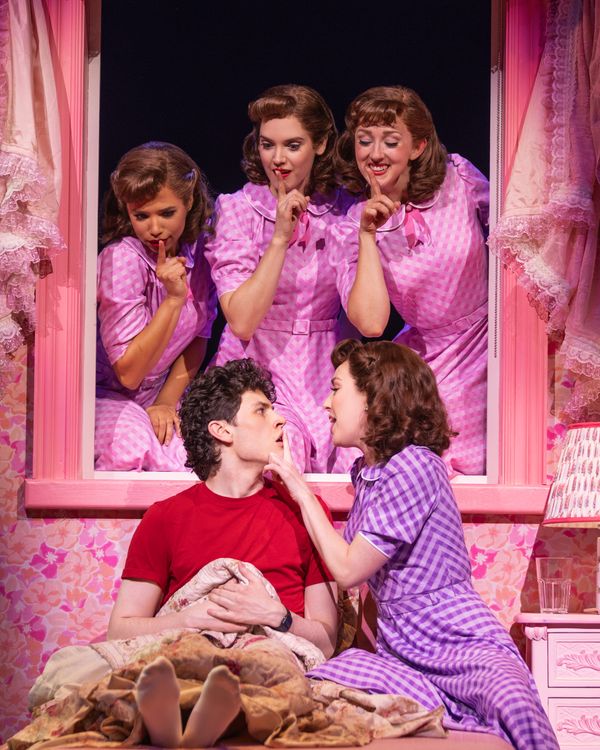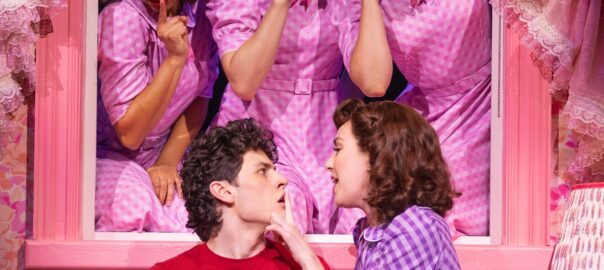[ad_1]

From Back to the Future: The Musical, at the Winter Garden.
Photo: Matthew Murphy and Evan Zimmerman
I think I first encountered Doc Brown and Marty McFly as a little kid on an amusement-park ride at Universal Studios, which I remember was confusing because I hadn’t yet seen any Back to the Future movies. Still, there was a certain elemental logic to the odd-couple pairing of a cool misfit kid and a local mad scientist as long as you didn’t think too hard about the logistics of their meeting. Besides, these 1970s and ’80s sci-fi franchises so dominated the culture (see also Star Wars and everything featured in Ready Player One) that trace elements of it were in the water supply for every Gen-Xer and millennial. Even if you’ve somehow never seen it, you know the ideas and can quote a few lines. “Roads? Where we’re going we don’t need roads!” is pretty nearly an American proverb.
That omnipresent cultural microplastic quality of Back of the Future in turn makes it strange to experience it head-on, loudly, in another medium. In Back to the Future: The Musical, director John Rando, writer Bob Gale (who co-wrote the original screenplay with the movie’s director, Robert Zemeckis), and songwriters Alan Silvestri (the film’s composer) and Glen Ballard (of Jagged Little Pill, the album, and Jagged Little Pill, the musical) are here to present you with a faithful, spectacle-heavy re-creation. It ends up reminding you primarily of just how strange the original is. It’s a bit like Marty’s own trip from the mid-’80s to the ’50s. He discovers that mid-century life wasn’t all sock hops and naïveté, that his dad was a dweeb, and that his mom, horror of horrors, had a sex drive. The audience, meanwhile, takes its own even longer journey back from 2023 to 1985. Remember straightforwardly stereotypical depictions of high-school bullies? Remember Huey Lewis?
As a general rule, the more famous the movie being adapted into a musical, the greater the pressure it exerts on the adaptation to stick to the expected course. Something like The Band’s Visit could quietly expand in its own direction, whereas Mean Girls and Moulin Rouge! sag under the weight of expectations. Creators can zag away from that by being flat-out weird, as in Beetlejuice; relentlessly exuberant, as in Legally Blonde; or introspective, as in Groundhog Day. Back to the Future simply tries to hold up its plutonium-weight source material. There are a few mild edits: Doc, instead of being attacked by a group of Libyan terrorists, now suffers from radiation poisoning, and Marty’s 1985 girlfriend, Jennifer (Mikaela Secada), is still absent from most of the story but joins in to sing across-the-decades harmony for a duet in the second act. But otherwise, they’re playing the hits down to the line about not needing roads, which gets translated into French on a chalkboard at the back of a classroom set.
That fidelity ties down the actors, who each have to deliver a performance really close to someone else’s. Casey Likes, who’s playing Marty and happens to be on his second movie-to-Broadway gig as a relatable white-guy audience stand-in after Almost Famous, works hard to do almost everything Michael J. Fox did. He adopts the upward-lilting line delivery and keeps his center of gravity a few feet ahead of him, entering a scene as if he has just sprinted over from across the street. In playing Doc Brown, Roger Bart doesn’t do Christopher Lloyd as much as an exaggerated, several-times-Xeroxed version of his character, as though he’s trying to reabsorb Rick and Morty back into the thing it began by parodying. His Doc, fittingly for a musical, is a showman, with an entourage of backup dancers in flame suits who appear behind him when he sings — giving him the chance to break the fourth wall, poke fun at the form, and note that he has no idea where they came from. But the hardest acting challenge falls to Hugh Coles, who has to approximate Crispin Glover’s extremely idiosyncratic version of a high-school nerd turned defeated dad. He does so by throwing his very long limbs all over the stage like a spider piloting a human suit. As with so much of the show, it’s impressive as a meticulous stage-to-screen translation of a vibe but less compelling in and of itself. The choices all curve back toward homage rather than expanding or complicating the original thing.
That’s where the songs, theoretically, could come in. Ballard and Silvestri have written some big ’80s power numbers (for the show’s present) and cutely ironic ’50s doo-wop (for its past), but how could they ever stand up against the old soundtrack? The musical incorporates not just “The Power of Love” and “Johnny B. Goode” but the distinctive horn fanfares from Silvestri’s soundtrack, which pop up as underscoring onstage. They stick like cooked spaghetti in your memory while everything new slides right off. When Marty’s mom, Lorraine (a game but underutilized Liana Hunt), falls for her own son, thinking he’s the hot new boy in town named Calvin Klein, she launches into a horny but retro seduction number that could well be a trunk song from Grease. The song succeeds as comedy, but the show doesn’t dig deeper into her psyche from there. The second-act reprise of the number is brief and remains lyrically vague. (“When I sit by your side, I just can’t describe feeling these feelings I feel,” goes a refrain, to which you want to say, “Describing feelings is a lyricist’s job!”) The show and the movie both portray her at a distance, from a viewpoint of Freudian comic horror and pity, compared with the more complete portraits of Marty and his father. She may have a lot to sing about — trying to express your sexuality when everyone, including your own son, wants you to repress it is a compelling predicament — but the creators aren’t interested.
There is so much else in Back to the Future, the movie, that could stand new scrutiny but doesn’t receive it. The whole plot is defensive about the hetero nuclear family; Marty has to make sure his parents get back together, and his plan involves making his dad more masculine and violent. Characters make fun of the irony of Reagan’s career path from cowboy actor to president, but the story sure comes with a lot of Reaganite ideas: When order is restored in the present, Marty’s parents aren’t just happy, they’re also, crucially, rich. These aren’t new points to make about the movie (at the time, Glover complained about the optics of the ending to Zemeckis and then didn’t return for the sequels), but it’s a pity to watch those same dynamics be recapitulated. Imagine a different, probably darker adaptation with a satirical Reaganomics number. Have the characters wink toward our dystopian present, which is dominated by tech nerds who love sci-fi stories just like Back to the Future. Well, to be fair, Doc does make a brief journey to the 21st century at the top of the second act, but the satire is toothless. It’s mostly about how we don’t have flying cars. His other big song, “For the Dreamers,” is a straightforward celebration of inventors. Hooray for STEM.
What Back to the Future does deliver instead of commentary on the original is a beat-by-beat translation of its set pieces. The DeLorean arrives onstage at the same time as Bart’s Doc, and actor and car split the entrance applause. When Marty gets inside and guns for 88 miles per hour, the screens around the stage blur behind him. (I felt right back in that Universal Studios amusement-park ride.) You’ll perhaps notice a V-shaped set of slats in the stage, ready to ignite behind the wheels of the car, and later on, the DeLorean soars into the air for its own “Defying Gravity” moment — turns out the flying cars are here. The stagecraft is well managed (Chris Fisher, of The Cursed Child, is credited with the illusions, while Finn Ross did the video design and Hugh Vanstone the lighting), but watching the climax, where Doc and Marty race to get everything set in time for lightning to strike, I kept noticing how much the musical nearly turned into a movie. The screens, which so dominate the set, provide for cuts between Doc and Marty, the score’s basically the one you know, and the actors are really there only to sit in a car and on a ledge and shout lines you know. When the ledge under Doc crumbles, that’s a screen too. If this is the future arriving on Broadway, it looks way too much like another medium’s past.
Back to the Future: The Musical is at the Winter Garden Theatre.
[ad_2]
Source link
